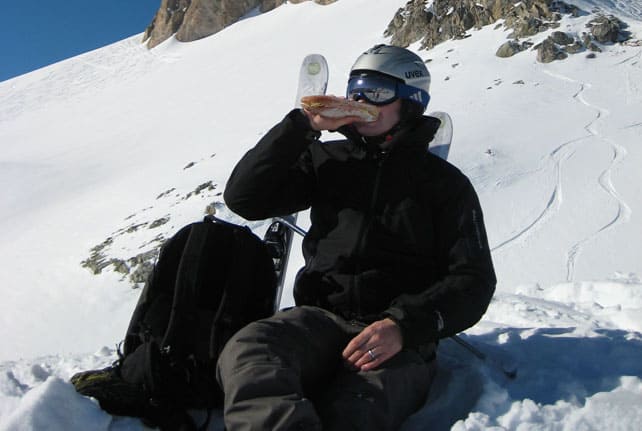
You know how it is on a skiing holiday: money can melt away faster than fresh powder in a spring thaw. So keep your holiday costs under control with these top money-saving tips.
Ski resorts aren’t exactly famous for being cheap, but look beyond the foie gras and glittering boutiques and you can find all sorts of ways to cut your costs. All it takes is an eye for discounts, some pre-booking before the trip, and a healthy dose of self-discipline when it comes to mountain restaurants. Here’s how.
1. Rent your skis and boots in advance
Need to rent skis and/or ski boots? Then, please, don’t leave it until you get to the resort. Skiers who book, and pay, online beforehand routinely get 20-50% off the cost from specialists such as Snowberry in Val d’Isere, or the big rental networks like Skiset and Intersport. It’s a good idea to make the booking as soon as you’ve sorted the holiday to be sure of bagging the best deal. In fact, in some cases you can book accommodation and discounted ski hire at the same time.
2. Bring your sunscreen and lippy from Britain
Of course, you can buy sunscreen and lip balm when get to your ski resort. But why pay €9 or €10 for a 50ml tube when you can buy four times that quantity at half the price back home? Stock up at your local supermarket in the week before the start of the trip.
3. Cook your own supper

For families, it’s tougher: whoever does most of the cooking at home needs some time off, so Mum and Dad should take it in turns. Takeaway pizza with a big salad from the fridge is a good option when both parents need a night off.
4. Do your shopping in the valley supermarkets
You can lower the cost of a self-catering holiday further by bringing essentials from home (olive oil, salt and pepper, soaps, etc) and then doing a big shop in one of the valley supermarkets for fresh produce, as well as beer and wine, on the final approach to the resort. Not only is there more choice than in the little convenience stores you find in most ski resorts, prices are significantly lower too. For example, Bourg St-Maurice is the place to stop if you’re heading up to Tignes, Val d’Isere or Les Arcs, and Moutiers for Meribel, Courchevel or Val Thorens.
5. Buy the right ski pass
There are two ways to save money on the price of a lift pass. The first is to make sure you only pay for the terrain you need. For example, beginners and early intermediates skiing in one of the big, combined ski areas like the Espace Killy or Three Valleys in France won’t need to buy a lift pass covering all the pistes. They should get a cheaper pass for their resort’s local slopes instead.
Keep an eye out for group discounts too. For example, the Family Pass from the Three Valleys offers a saving of €55pp on the price of individually-purchased six-day passes for two adults and two teenagers.
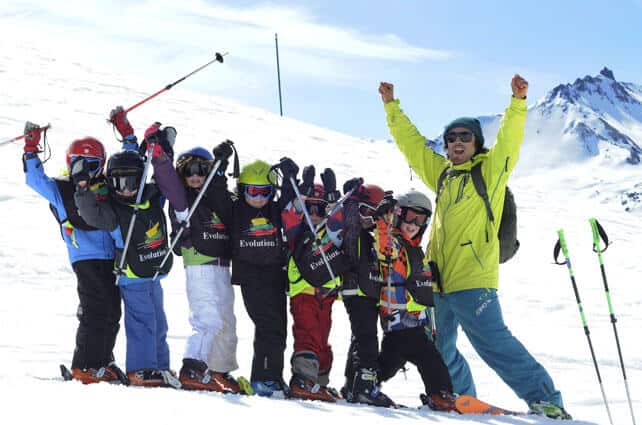
6. Or get it for free
Do you need to buy a lift pass at all? If you have kids, it’s worth shopping around before the trip to see which resorts offer free lift passes for their age group. For example, Obergurgl in Austria offers free lift passes for children under the age of nine. Meanwhile, beginners sometimes get free access to the lifts on a resort’s nursery slopes – for example in Val d’Isere. Keep your eyes peeled for come-hither holiday deals which sometimes bundle up lift passes with accommodation, too.
7. Book ski lessons for the afternoon
Ski lessons are often cheaper in the afternoon than the morning. For example, with the ESF in Alpe d’Huez, a course of six afternoon lessons costs €154, compared with €169 for a similar course in the morning.
8. Learn to love soup

In France a thick vegetable potage will do the trick. The one pictured above came from Le Panoramic in Tignes, and cost €6. Add cheese and croutons until it’s virtually solid, and it’ll keep you motoring till suppertime.
9. Or ski back into town for lunch
Looking for something more substantial than soup? Then remember the restaurants in town are almost always cheaper than the ones up on the slopes. In many resorts you can choose between proper sit-down meals, a quick pancake (sweet or savoury), or something sinful and deeply satisfying such as the famous Mountain Burger in Meribel-Mottaret. You should also learn to exploit your accommodation too. Many French families ski back to their self-catering apartments to eat lunch there.
10. Pack a picnic
Every skier needs a 20-25 litre rucksack, if only to carry a bottle of water and some extra layers of ski clothing in case it gets cold. But why not use it to carry your lunch around in as well?
If you’re staying in an apartment, then making your own sandwiches is an obvious start to the day. If you’re not, then you’ll find them pre-made in the local bakery. Add a flask full of coffee or hot chocolate into the mix, and – if the weather’s good – you’ve got the makings of memorable picnic, served up with stunning scenery and the happy thought you’re saving at least £5-£10 per head on the cost of lunch.
And don’t forget the quality of ingredients will be rather better than they are back home. Here’s a short video from a few years back by ace mountain film-maker Seb Montaz-Rosset to get us all excited about proper cheese.
11. Or save your hunger for teatime
Brits who are staying in catered chalets can ski right through lunch because they know they can pig out on tea and cake at 4pm, back at base. The same goes for anyone holidaying an upmarket Austrian hotels. Many lay on a big spread in the afternoon – which includes soup and savoury snacks, as well cake and biscuits.
12. And keep an eye out for happy hour
A vigorous programme of après-ski will make a big hole in any skier’s budget, so lighten the load by focusing on bars with happy hours. In Val d’Isere, for example, Victor’s has a handy two-for-one cocktail hour which stretches from 9-11pm, and is all but guaranteed to get the evening off to a rip-roaring start. In Chamonix, the Monkey Bar has two separate happy hours: one for beer, wine and soda (4-6pm) and the other for cocktails (9-10pm).
For more tips on keeping costs down, check out Welove2ski’s guides to affordable ski holidays and ski resorts that offer good value for money.


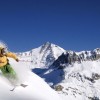

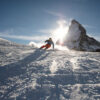





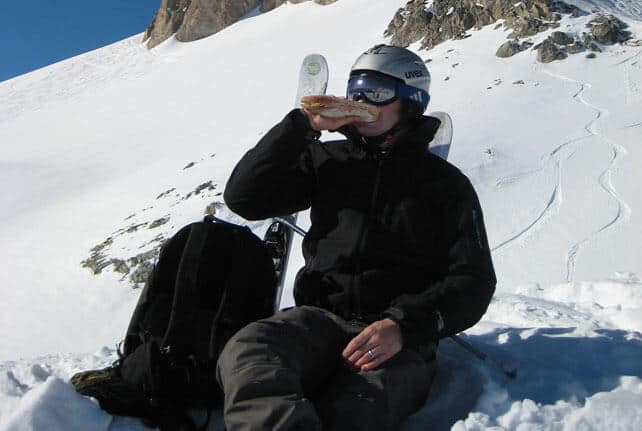
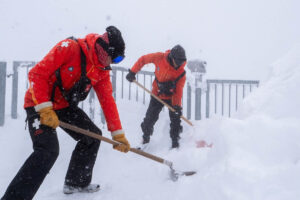

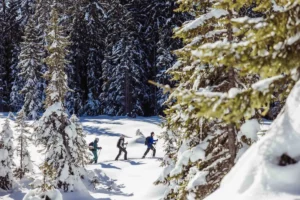
I wasn’t feeling hungry until I watched that video! Good tips, thanks
When I was (a lot) younger I was so keen to keep skiing I didn’t bother with lunch (but it wasn’t to save money). Now I refuse to do without lunch – can’t bear the idea of a sandwich, sorry. You might, however, like to know about the habits of some skiers in Trysil, Norway which I wrote about once: “Slopeside snacks are a big thing in Norway. Skiers pack picnics in their knapsacks – including a good few miniature bottles of akvavit – and during the early afternoon duly halt their skiing to enjoy it. The main ingredient is often something their Swedish neighbours would call surströmming, a delicacy made from fermented Baltic herring, and loosely translated as ‘stinking fish’. It sounds horrible, and smells worse, but it tastes wonderful – as long as you don’t breathe in through your nose.” Yuck.